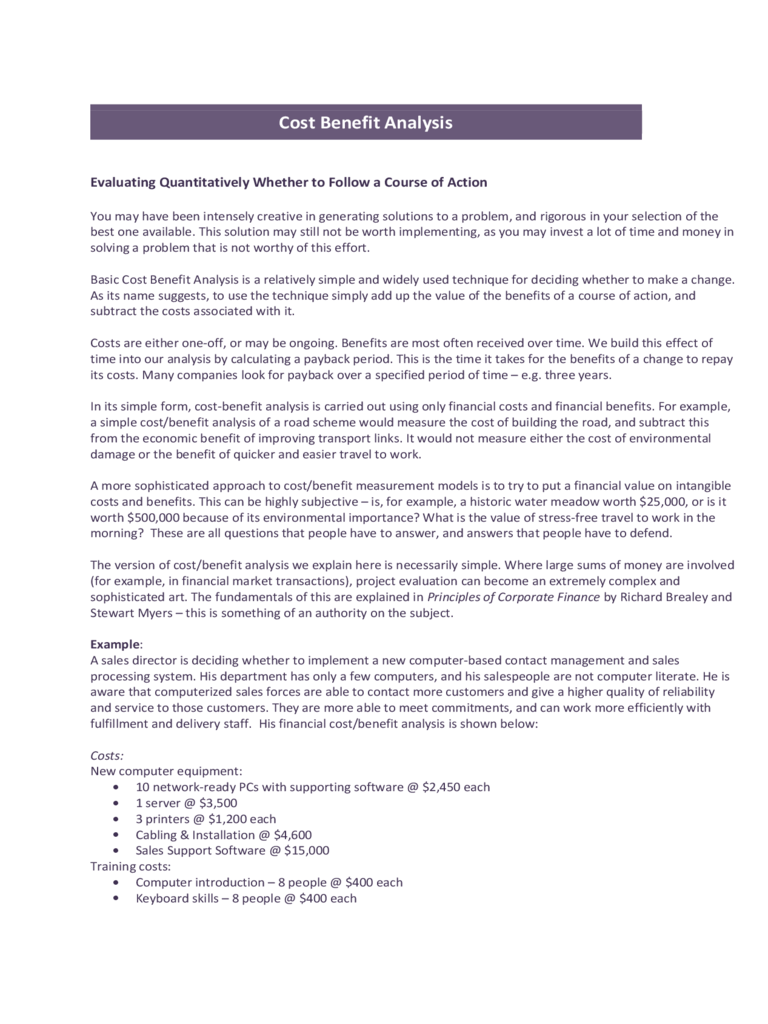Fillable Printable Sample Cost Benefit Analysis
Fillable Printable Sample Cost Benefit Analysis

Sample Cost Benefit Analysis

Cost Benefit Analysis
Evaluating Quantitatively Whether to Follow a Course of Action
You may have been intensely creative in generating solutions to a problem, and rigorous in your selection of the
best one available. This solution may still not be worth implementing, as you may invest a lot of time and money in
solving a problem that is not worthy of this effort.
Basic Cost Benefit Analysis is a relatively simple and widely used technique for deciding whether to make a change.
As its name suggests, to use the technique simply add up the value of the benefits of a course of action, and
subtract the costs associated with it.
Costs are either one-off, or may be ongoing. Benefits are most often received over time. We build this effect of
time into our analysis by calculating a payback period. This is the time it takes for the benefits of a change to repay
its costs. Many companies look for payback over a specified period of time – e.g. three years.
In its simple form, cost-benefit analysis is carried out using only financial costs and financial benefits. For example,
a simple cost/benefit analysis of a road scheme would measure the cost of building the road, and subtract this
from the economic benefit of improving transport links. It would not measure either the cost of environmental
damage or the benefit of quicker and easier travel to work.
A more sophisticated approach to cost/benefit measurement models is to try to put a financial value on intangible
costs and benefits. This can be highly subjective – is, for example, a historic water meadow worth $25,000, or is it
worth $500,000 because of its environmental importance? What is the value of stress-free travel to work in the
morning? These are all questions that people have to answer, and answers that people have to defend.
The version of cost/benefit analysis we explain here is necessarily simple. Where large sums of money are involved
(for example, in financial market transactions), project evaluation can become an extremely complex and
sophisticated art. The fundamentals of this are explained in Principles of Corporate Finance by Richard Brealey and
Stewart Myers – this is something of an authority on the subject.
Example:
A sales director is deciding whether to implement a new computer-based contact management and sales
processing system. His department has only a few computers, and his salespeople are not computer literate. He is
aware that computerized sales forces are able to contact more customers and give a higher quality of reliability
and service to those customers. They are more able to meet commitments, and can work more efficiently with
fulfillment and delivery staff. His financial cost/benefit analysis is shown below:
Costs:
New computer equipment:
10 network-ready PCs with supporting software @ $2,450 each
1 server @ $3,500
3 printers @ $1,200 each
Cabling & Installation @ $4,600
Sales Support Software @ $15,000
Training costs:
Computer introduction – 8 people @ $400 each
Keyboard skills – 8 people @ $400 each

Sales Support System – 12 people @ $700 each
Other costs:
Lost time: 40 man days @ $200 / day
Lost sales through disruption: estimate: $20,000
Lost sales through inefficiency during first months: estimate: $20,000
Total cost: $114,000
Benefits:
Tripling of mail shot capacity: estimate: $40,000 / year
Ability to sustain telesales campaigns: estimate: $20,000 / year
Improved efficiency and reliability of follow-up: estimate: $50,000 / year
Improved customer service and retention: estimate: $30,000 / year
Improved accuracy of customer information: estimate: $10,000 / year
More ability to manage sales effort: $30,000 / year
Total Benefit: $180,000/year
Payback time: $114,000 / $180,000 = 0.63 of a year = approx. 8 months
Tip:
The payback time is often known as the break even point. Sometimes this is is more important than the overall
benefit a project can deliver, for example because the organization has had to borrow to fund a new piece of
machinery. The break even point can be found graphically by plotting costs and income on a graph of output
quantity against $. Break even occurs at the point the two lines cross.
Inevitably the estimates of the benefit given by the new system are quite subjective. Despite this, the Sales
Director is very likely to introduce it, given the short payback time.
Key Points:
Cost/Benefit Analysis is a powerful, widely used and relatively easy tool for deciding whether to make a change.
To use the tool, first work out how much the change will cost to make. Then calculate the benefit you will from it.
Where costs or benefits are paid or received over time, work out the time it will take for the benefits to repay the
costs.
Cost/Benefit Analysis can be carried out using only financial costs and financial benefits. You may, however, decide
to include intangible items within the analysis. As you must estimate a value for these, this inevitably brings an
element of subjectivity into the process



